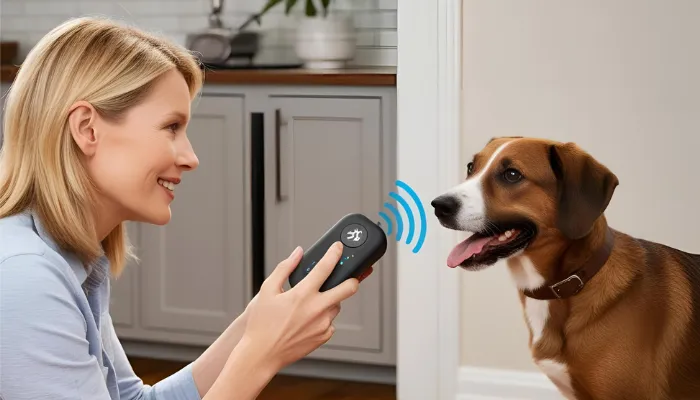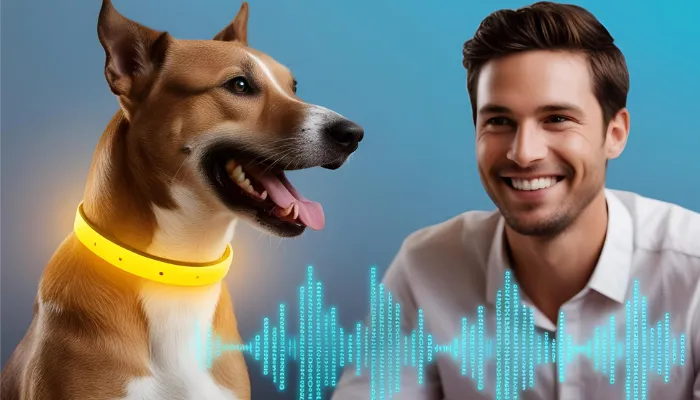A human to dog translator is an intriguing concept that has fascinated pet owners for years. The idea of being able to communicate with our furry friends in a way they understand is both exciting and revolutionary.
With advancements in AI and technology, many tools, including Human to Dog Translator Online Free, claim to bridge this gap. But how do this dog translator work? Are they accurate? In this article, we’ll dive deep into the mechanics of translators, exploring their technology, effectiveness, and potential future advancements.

Human to Dog Translator: How It Works?
To comprehend how a Human to Dog Translator works, it is essential to know how dogs communicate. Dogs communicate using body movements, sounds, and scent. Unlike humans, dogs do not have a formal language. Instead, they use barks, growls, and whines to communicate their feelings and needs.
In the case of dog to human translators, they function by listening to these vocalizations and correlating them with general feelings or words associated with most dogs. The process is as follows:
1. Voice Recognition & Analysis
- The device captures a human’s voice and interprets it.
- It singles out significant words identified in the initial phase.
- Advanced AI or algorithms turn these selected words into dog-compatible vocalizations.
- Certain systems have been developed that are able to learn through machine learning. This helps them achieve more precision with every repetition of the process.
2. Sound Frequency Modulation
- Translators for dogs modify the sounds through the pitch and frequency which dogs are able to grasp.
- A human’s voice is transformed into sounds that resemble a dog barking.
- Dogs respond better to higher frequencies so anything above the dog’s call will be utilized.
3. Pre-Recorded Canine Sounds
- Dog translators are able to use barking, growling, or whining sounds from a recording.
- The sounds relate to specific human emotions and feelings.
- Some gadgets harness the possibility of enabling modification prior to recording in order to capture the dog’s specific character and behavior.
4. Behavioral Response Analysis
- More advanced models study the dog’s response to the translations.
- They adjust upcoming translations for improved precision
- Some systems incorporate the real-time feedback of the dog’s actions to adjust the translations done in real-time.
No translator is capable of comprehensively understanding a dog’s mind, but these devices undeniably provide a novel and enjoyable way for pets and their owners to interact.

Types of Human to Dog Translators
There are various types of dog language translator tools, each with a unique approach to canine communication:
| Type | Description | Accuracy Level |
|---|---|---|
| Mobile Apps | AI-powered apps that analyze human voice and convert it into canine sounds | Moderate |
| Handheld Devices | Physical devices that emit dog-friendly sound frequencies | High |
| Online Translators | Web-based tools like Human to Dog Translator Online Free that generate dog-friendly sounds from text or speech | Low to Moderate |
| Wearable Dog Collars | Smart collars with built-in sound modules to translate emotions | High |
Each type varies in efficiency, with AI-based wearable collars leading the way in real-time communication accuracy.
Do Human to Dog Translators Really Work?
How fascinating would a human to dog translator be? Now, one could truly wonder whether we have the means to effectively communicate with our furry companions. Nonetheless, converting barks, growls, and howls into language that humans understand is more nuanced than its very syntax.
Pros:
- Assists owners in identifying most of the common emotions canines express like happiness, fear, or distress.
- Especially beneficial in the latter stages of training where the bond between humans and pets is deepened.
- Offers pet owners a source of amusement and active involvement with their pets.
Cons:
- Dogs lack elaborate language systems; their communication includes gestures, sounds, and even smell.
- Some dog translator app tools produce sounds without understanding true meaning.
- Results depend on the canine’s breed, dominance, and past training methodology.
Studies & Research:
Research proves that dogs are capable of recognizing and associating up to 100 different words, but that is purely based on conditioning. On top of that, dogs constitute an active element in all the systems as they respond better to tone, pitch, and body language rather than specific words.
The thought processes of a dog may forever remain outside the realm of human comprehension, but the experience of trying is simply delightful!

How to Use a Human to Dog Translator Effectively?
Using a dog translator can be an interesting and interactive way to connect with your pet, but you need to be aware of a few essential things for optimal results before you start. Here are some tips for maximizing the dog translator’s features:
1. Choose your Software Wisely
- Ensure that the tool you prefer is backed with strong reviews and has features like AI and other functionalities.
- In case of doubt, research a Human to dog Translator Online free before committing to a more expensive option.
2. Issue Clear Instructions
- Canines tend to process and respond more efficiently to distinct and concrete words phrased in a brief manner.
- Examples: “Sit,” “Come,” “Stay,” “Good boy!”
- Do not attempt incomplete phrases as dogs are not capable of comprehending sentences.
3. Watch for Signs of Emphasis
- Focus on whether dogs perk their ears, tilt their heads, or follow commands.
- If confused, try changing your tone, speaking more slowly or utilizing a different word.
4. Mirror With Your Words
- As the dog needs to understand the context, it should be imprinted clearly with the appropriate signals, received visually and verbally.
- For instance, to command the dog to stay, place your palm outwards in front of you, and vice versa for the sit command.
5. Reassurance & Effort
- Expecting dogs to grasp information instantly is a fool’s motto; the same goes for repetition.
- Be sure to treat, praise or encourage the dogs after positive actions as a way to reward and motivate them.
A combination of training techniques and dog bark translator tools can help strengthen communication with your pet.
Best Human to Dog Translator Apps & Tools
All of the tools differ from one another in terms of functionality, thus, trying out some of them will help you determine which one specifically suits your pup’s personality and communication style.
| Name | Features | Platform |
|---|---|---|
| Dog Translator Simulator | Mimics dog sounds | Android, iOS |
| Pet Translator | Voice recognition, AI-based | Android, iOS |
| Human to Dog Translator Online Free | Web-based translation tool | Online |
| BowLingual Dog Translator | Advanced AI learning system | Physical Device |
Each of these tools offers unique functionalities, so experimenting with a few can help you find the best match for your pup’s personality and communication style!
If you’re looking for a fun way to interact with your pet, an English to Dog Translator can help mimic canine sounds for better engagement.
Future of Human to Dog Translators
With the evolution of modern technology, the translation of human words to dog language seems to become more realistic and beneficial. Progress in AI technologies and communication approaches is facilitating understanding between human beings and their four-legged friends further.
Advancements In AI And Algorithms
- Improved algorithms are likely to be put into complex canine behavior which can then be utilized in translations.
- AIs could tell various forms of barking, whimpering, and growling to better understand a dog’s emotions and its desires.
Wearable Devices
- Smart collars enabled with sensors could track heart rate, body temperature, and movement to analyze one’s emotions in real-time.
- Other devices could hypothetically transform signals into speech or sounds that people understand.
Communication Through Brain Waves
- Researchers are working on direct brain-to-brain technology which could let people someday know what does a dog thinks.
- Further development of EEG and decoding of neural signals are turning out to be encouraging.
Advanced Mobile Applications
- Future applications will contain features like better voice detection and enhancement of learning, along with custom profiles for dogs based on their breed, age, and traits.
- Some may even be compatible with IoT devices to promote easier interaction with pets.
With these advancements, how to speak dog language translator technology is bound to become more precise, transforming our relationship with dogs.
Conclusion
The concept of a human to dog translator is exciting and continues to evolve with AI advancements. While tools like Human to Dog Translator Online Free provide a fun way to interact with pets, they are not yet perfect at decoding canine speech. However, with continued development, the dream of truly understanding our furry companions might soon become a reality!
If you’ve ever wondered what your dog is thinking, trying out a human to dog translator could be a fun experiment. Who knows? One day, we might just be having full conversations with our dogs!
